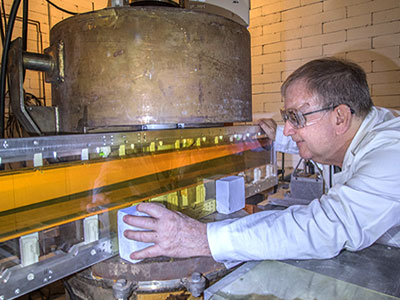Facilities and Infrastructure
Irradiation Sources
Electronics and structural materials intended for use in high-energy physics experiments, space, or other environments where significant amounts of damaging radiation are present must be tested and qualified for radiation effects before they are deployed. The Instrumentation Department’s solid-state gamma-ray irradiation facility, neutron generator, and other small neutron sources provide capabilities to perform these testing and characterization studies in air.
Our Capabilities
- Determination of long-term radiation exposure effects with an ionizing radiation source (~60Co, 450 Ci activity in 2020) capable of operating continuously without interruption
- Characterization of handheld-size samples at high dose rates (up to 4×104 rad/hr, or 1 Mrad over one day) and samples as large as 60 cm at low dose rates (down to 100 rad/hr)
- Implementation of complex test setups near the radiation source, allowing for studies at temperatures ranging from cryogenic to elevated and under vacuum or in selected gas atmospheres
- Movement of shielded enclosure to modify dose rate for dynamic studies, even during irradiation
- Measurement of low-level displacement damage via neutrons (14 MeV neutron generator and sealed sources)
Case Studies
Simulating the ATLAS Environment
Readout application-specific integrated circuits (ASICs) for the Silicon Strip Detector ATLAS High-Luminosity Large Hadron Collider (LHC) Upgrade consume more power with increasing ionizing radiation dose up to a peak power consumption. Afterward, the power consumption decreases with additional radiation dose, approaching its original value. The ability to reproduce an environment similar to that of the ATLAS experiment and simultaneously irradiate multiple setups over months was indispensable to the upgrade group in characterizing this behavior. These measurements validated the hypothesis that pre-irradiation of the ASICs prevents the power increase from occurring—an approach adopted for the upgrade.
Quantification of Radiation Damage
The Electron-Ion Collider (EIC) is a nuclear physics research facility that will be built at Brookhaven. Essential to the success of EIC are high-quality, optically clear Cherenkov radiation detectors immune to damage from ionizing radiation. Using our gamma-ray irradiation facility to irradiate optical samples and a monochromator to quantify radiation damage, the EIC team is identifying the best materials for these detectors.
sPHENIX SiPM Radiation Damage
The sPHENIX nuclear physics experiment at Brookhaven’s Relativistic Heavy Ion Collider will probe the nature of the quark-gluon plasma—a state of matter that filled the early universe—by colliding atomic nuclei at high energies. The sPHENIX detector recording the particles emerging from these collisions has more than 100,000 silicon photomultipliers (SiPMs), which will be subjected to high fluxes of neutrons and doses of gamma radiation. Prior to deployment in the detector, sPHENIX collaborators measured the radiation damage of representative SiPMs during and after irradiation in our gamma-ray irradiation facility. These data were essential in optimizing the performance of the SiPMs and other electronic devices for the final detector.





